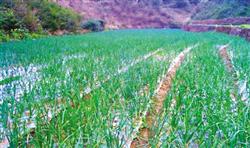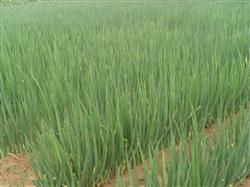You can get more onions in the cotton industry in one fell swoop.

Interplanting cotton with onions is one of the good models. This model has many advantages, first, cotton and onion can achieve two stages of symbiosis, that is, cotton symbiosis with cotton harvest in autumn, and cotton seedling symbiosis in spring, there is no symbiotic contradiction between the two intercropping; second, cotton and onion interplanting can improve multiple cropping index, cotton interplanting onion with wide row, narrow row can interplant other vegetables; third, onion is easy to transport, storage, dormancy period is long, do not worry about sales, can adjust the remaining shortage of the market. Fourth, it can prolong the effective growth period of cotton and ensure that autumn peaches and late autumn peaches mature as scheduled; fifth, onions have a spicy taste, which can ward off cotton aphids and red spiders, reduce drug costs and reduce public pollution; sixth, it can improve double sets of benefits and increase the income of cotton fields by 300-500 yuan per mu. In order to give full play to the advantages of cotton and onion interplanting, the following points should be mastered in interplanting techniques. Push plants in parallel and fine ground preparation: when the cotton harvest of a large number of Fu peach and early autumn peach is nearing the end, the cotton plant is pushed to the edge of the cotton field to expose a wide line, which is about the middle of October. Then ploughing wide rows, because onions are fibrous roots, the roots are not deep, in order to facilitate the absorption of fertilizer and water, first, we should choose cotton fields with medium fertility and loose soil; second, we should make fine soil preparation so that the soil is fine and broken; third, we should combine soil preparation with mature organic ash fertilizer, with an average of 2500 kg per mu and 7.5-10 kg of potash fertilizer. Fourth, it is necessary to clean the ditch box of the cotton field while preparing the soil to prevent the soil clogging from causing waterlogging. At the same time, pay attention to prevent onions from replanting. Suitable for sowing onions, timely interplanting: onions are sown and raised from early September to early October, using red-skinned varieties with mid-maturity. It can be interplanted in wide rows of cotton in early November. The density of onion per mu is 1.5-20000 plants. The symbiotic period of onion and cotton is 30-50 days. The average yield of onion and lint is 750kg / mu and 1000 kg / mu, respectively. The benefit is considerable than that of cotton and wheat double cropping. Multiple uses, double sets of cotton vegetables: cotton wide row in addition to onions, cotton narrow row can also interplant radish, spinach, interplanting pakchoi. The average income of narrow row set vegetables per mu can be increased by 100-200 yuan. After spring, the onion was used as the previous stubble, and cotton was interplanted in mid-late April. It can not only promote the early growth and rapid development of cotton, but also reduce cotton seedling pests. Due to the spicy taste of onions, cotton seedlings are basically free of aphids and red spiders. The symbiotic period of cotton and onion is 40-50 days, and there is no symbiotic contradiction.
- Prev

The "five hurdles" should be taken to raise onion seedlings in autumn.
Onion has the characteristics of low input, high yield, simple management and high benefit, so it is an ideal vegetable variety for vegetable farmers to commercialize production and increase income. The first ten days of September is the best time for raising onion seedlings. The main points of seedling raising techniques are introduced as follows. Seed selection can choose Ziyu No. 1 and Ziyu in production.
- Next

Planting green onions and doing a good job of field management in autumn
Planting techniques are as follows: first, preparation before sowing: (1) selection of varieties with strong growth potential, disease resistance and high yield, such as high white sycamore, Gaobai new generation, specially selected Gaobai and other excellent varieties. (2) the sowing date of Welsh onion in autumn is from September 25th to October 5th in Shandong, and the temperature of 5cm is ten days.
Related
- Where is it suitable to grow horseradish in China? it is expected to see the middle altitude horseradish in Alishan.
- How to prevent tomato virus disease reasonably? (Control methods included)
- Many people like to plant towel gourd on the balcony. What are the main points of this method and management?
- What crops can chili peppers be mixed with?
- Fertilization techniques and matters needing attention in Tomato
- What are the grafting techniques for peach seedlings in spring?
- Harm and control methods of root swelling disease of Chinese cabbage
- What are the pests of sweet potatoes? How to prevent and cure it?
- Symptoms, causes and Control methods of navel Rot in Tomato
- The cause of "Cucumber rotten bibcock" in Farmers' planting Cucumber and its Control Plan

